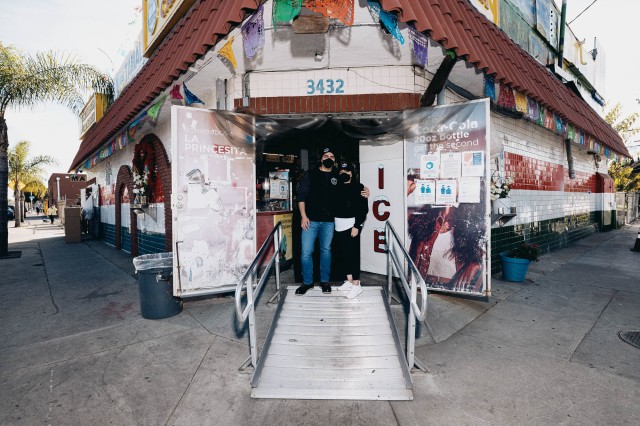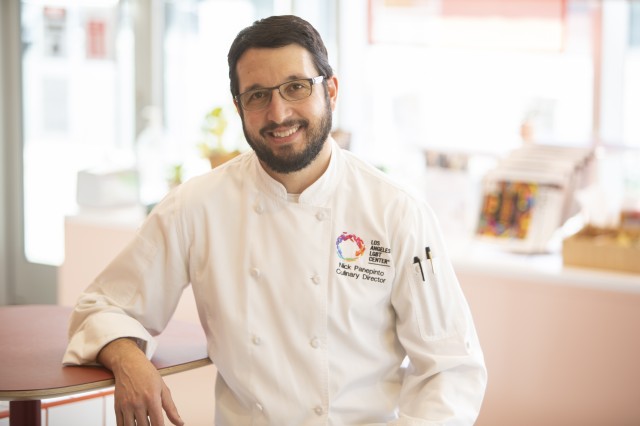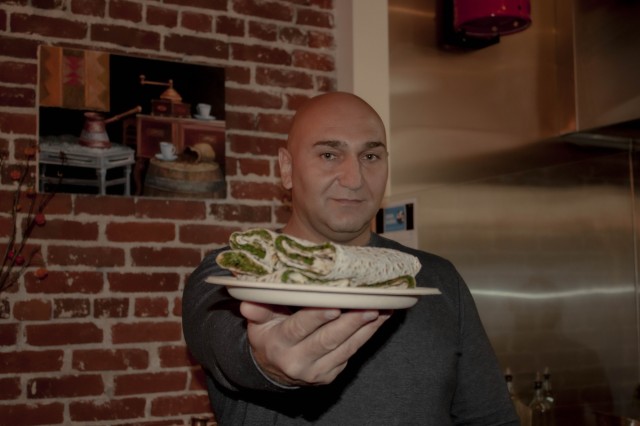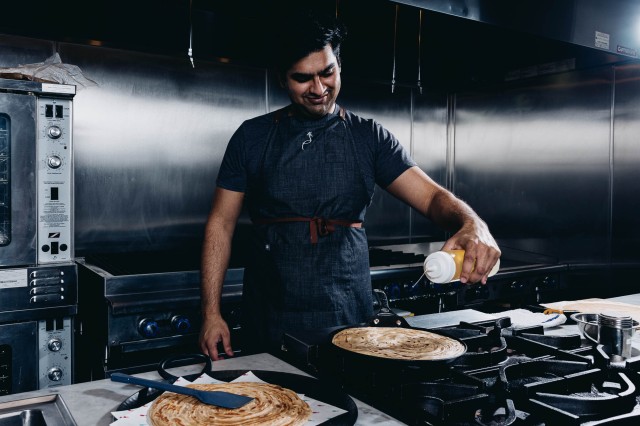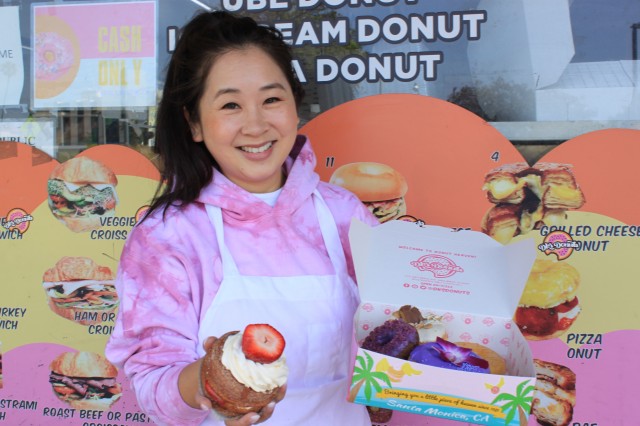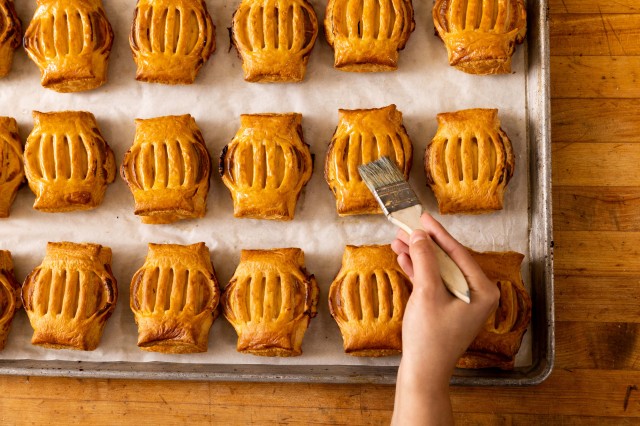
The Hart Museum remains closed. Los Angeles County has approved a plan to transfer the William S. Hart Museum and Park from the County to the City of Santa Clarita.

Kneaded: L.A. Bread Stories celebrates Los Angeles’ history, heritage, and communities through the lens of bread.
Long Beach is a vibrant place for artists of all mediums. With so many creative people in a community, unique ideas are bound to take off. Arturo Enciso and Ana Belén Salatino moved onto a property in downtown Long Beach with an outdoor cob oven; he found inspiration to try something new. Now this musician turned baker provides his community with culinary masterpieces at Gusto Bread.
What I love about Gusto as a name for our bakery is the bilingual nature of the word. Gusto means doing something with grace, artistic expression, and passion in English. In Spanish, gusto means taste, flavor, or pleasure. So, [the word] encompasses my bread journey in both English and Spanish–and I love that because bread does feel like an art to me, and I do this work with passion and grace. I do my best to stay true to the name.
Arturo Enciso
Tell me a bit about yourself and how you got started.
I grew up in Lebec, California, a small town near Bakersfield, and moved to Long Beach in 2008. I was working as a musician until I found bread. It all happened because my partner and I moved onto a property in downtown Long Beach that shared a garden area with the homeowner. In this space, there was a cob oven. Like an adobe oven, cob ovens are made of wood, clay, straw, and sand. I was amazed by the sight of it and really wanted to learn how to use it. I met another neighbor who helped build the oven, and he lent me his books on wood-fired ovens. I tried it out and really loved using the oven. I was passionate about coming home from work and baking bread in the cob oven; eventually, I realized that baking bread was what I wanted to do. I told Ana that I wanted to open my own bakery.
What was your journey from the cob oven to your oven at Gusto Bakery?
I was so excited to start bread making that I was ready to drop everything and make it work. Luckily Ana came at the idea in a more practical way. She advised me to get some first-hand experience working in a bakery. I did this by traveling around Los Angeles, dropping into bakeries, and asking bakers if I could interview them or ask if they were willing to share their process–and watch them work. I also did this when we went on short vacations or traveled to the East Coast, like Maine or New York. I took any chance to try a new bakery.
While visiting my oldest brother in Spain, I had one of the most inspiring experiences. I researched a small village with sixteen wood-fired ovens and a co-op of bakers who worked together to distribute their bread. It was such a cool model.
When I returned from Spain, I tried working in a few bakeries here in L.A., but it wasn’t the right fit for me since I wanted to do my own thing. I took a three-day baking class in Vermont where the instructor empowered me and gave me the validation I needed to take that leap and start my own bakery.
From 2017 to 2020, we had a cottage bakery, where we worked out of our home and sold bread to local restaurants, did home deliveries, and participated in farmer’s markets. In 2020, the city of Long Beach was working hard to promote local business owners, and the owner of the building we are in today heard our story. They approached us and asked if we wanted to rent the space–and of course, we did! So here we are today.
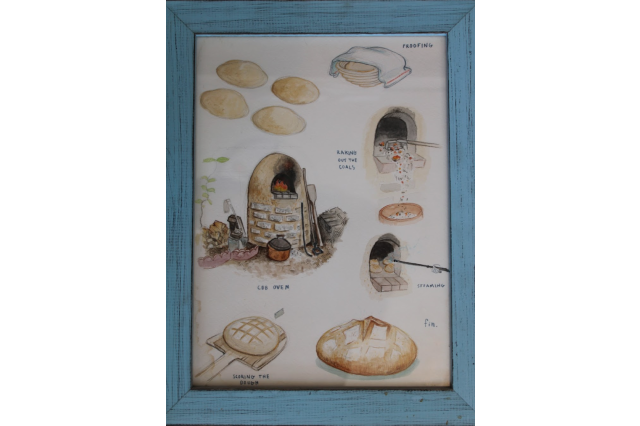
Artist Gabriel Gaete illustrated the cob oven Arturo used to get his start in baking and detailed the process.
Arturo has a passion for baking.
1 of 1
Artist Gabriel Gaete illustrated the cob oven Arturo used to get his start in baking and detailed the process.
Arturo has a passion for baking.
Tell us about making pan de maíz (corn bread) and your favorite part of the process.
I enjoy milling the maíz the most. I like seeing the maíz being ground up and my control over how it turns out. Controlling how fine or course I want the maíz to be, helps me experiment and choose what I want to use. Some days I will bring in yellow maíz like I am using today, but next time, I will bring in blue maíz. Exploring so many different flavors is just incredible.
Gusto Bread purchased its mill from the Jansen Grist Mill Company. This small business consists of a father-and-son team building their mills in their garage–which resonated with Arturo and his bread-making journey.
A handful of yellow maíz about to begin their journey to become Gusto Bread’s delicious pan de maíz.
Arturo loves the satisfaction of controlling how coarse or fine to grind each batch of maíz.
The small amount of ingredients necessary are proof that sometimes less is more.
Each batch of Gusto Bread’s pan de maíz is lovingly mixed by hand.
The tiny bits of ground maíz that were ground to perfection are visible in the final product–pan de maíz.
Are you hungry yet?
1 of 1
Gusto Bread purchased its mill from the Jansen Grist Mill Company. This small business consists of a father-and-son team building their mills in their garage–which resonated with Arturo and his bread-making journey.
A handful of yellow maíz about to begin their journey to become Gusto Bread’s delicious pan de maíz.
Arturo loves the satisfaction of controlling how coarse or fine to grind each batch of maíz.
The small amount of ingredients necessary are proof that sometimes less is more.
Each batch of Gusto Bread’s pan de maíz is lovingly mixed by hand.
The tiny bits of ground maíz that were ground to perfection are visible in the final product–pan de maíz.
Are you hungry yet?
How does your bread bring the community together?
Well, bread just naturally brings people together, right? While food generally brings people together, there is so much symbolism with bread.
Breaking bread and talking to people is what happens at Gusto Bread. You get a different experience when you buy bread from a bakery compared to a grocery store. While people wait in line to buy bread here, they talk to each other and are friendly. I have witnessed the community coming together.
The people who live here have a lot of pride in Long Beach. The community is very supportive of each other and of people with extraordinary stories doing great things. Our bakery is on Fourth Street, and this street means a lot to Ana and me–this neighborhood is all about artists helping other artists, so it felt like the perfect place. We’re not your typical bakery and are proud to do things differently–like use a sourdough starter in our bread which takes more time and is not the norm. We feature the work of other artists on our bread in the bakery and feel supported by the community.

What would you want others to know about the community you serve?
I’m amazed at how the Long Beach community helped us get here and also how friendly everyone is to others. It’s a loving community, and I'm blown away by how supportive people here are to us and each other. There have been people who brought their family members visiting from Mexico or other places here to our bakery and expressed their excitement to have them visit us. I’ve met so many abuelas (grandmothers)! It feels so special that we can create that experience for someone.
Following the success of Kneaded: L.A. Bread Stories, we're celebrating the history, heritage, and communities of Los Angeles through the lens of different cultural traditions. This year, L.A. at Play highlights the vibrant and visionary work of artisans who fabricate dolls and figurines using a variety of techniques and materials.
